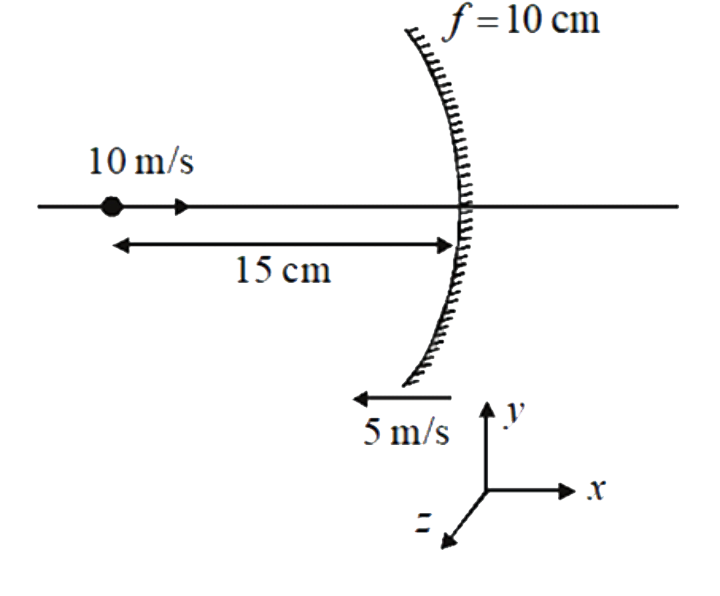Two waves are approaching each other with a velocity of 20m/s and frequency n. The distance between two consecutive nodes is
20n
10n
5n
n10
The correct Answer is:b
To find the distance between two consecutive nodes for the given waves, we can follow these steps:
Step 1: Understand the concept of nodes and antinodes
Nodes are points where the two waves cancel each other out, resulting in minimum amplitude. The distance between two consecutive nodes is half the wavelength (λ/2) of the waves.
Step 2: Use the wave velocity formula
The velocity (V) of a wave is related to its frequency (f) and wavelength (λ) by the formula:
V=f⋅λ
Step 3: Substitute the known values
In this problem, the velocity (V) is given as 20 m/s, and the frequency (f) is given as n. We can substitute these values into the formula:
20=n⋅λ
Step 4: Solve for wavelength (λ)
Rearranging the equation to solve for λ gives:
λ=20n
Step 5: Find the distance between consecutive nodes
Since the distance between two consecutive nodes is half the wavelength, we can express this as:
Distance between nodes=λ2
Substituting the value of λ we found:
Distance between nodes=20/n2=10n
Final Answer
Thus, the distance between two consecutive nodes is:
10n
Nodes are points where the two waves cancel each other out, resulting in minimum amplitude. The distance between two consecutive nodes is half the wavelength (λ/2) of the waves.
The velocity (V) of a wave is related to its frequency (f) and wavelength (λ) by the formula:
V=f⋅λ
In this problem, the velocity (V) is given as 20 m/s, and the frequency (f) is given as n. We can substitute these values into the formula:
20=n⋅λ
Rearranging the equation to solve for λ gives:
λ=20n
Since the distance between two consecutive nodes is half the wavelength, we can express this as:
Distance between nodes=λ2
Distance between nodes=20/n2=10n
Thus, the distance between two consecutive nodes is:
10n
Similar Questions
y1=8sin(ωt−kx)andy2=6sin(ωt+kx) are two waves travelling in a string of area of cross-section s and density rho. These two waves are superimposed to produce a standing wave.
(a) Find the energy of the standing wave between two consecutive nodes.
(b) Find the total amount of energy crossing through a node per second.
View SolutionTwo identical balls are approaching towards each other on a straight line with velocity 2m/s and 4m/s, respectiely. Find the final velocities after elastic collision between them.

View Solution
Knowledge Check
A sound wave having wavelength λ forms stationary waves after reflection from a surface. The distance between two consecutive nodes is
AλBλ/2Cλ/4Dλ/8
A progressive wave moves with a velocity of 36m/ s in a medium with a frequency of 200Hz. The phase difference between two particles seperated by a distance of 1 cm is
View SolutionAn object and a concave mirror are approaching each other with velocities 10 m/s and 5 m/s as shown in figure. The velocity of image of object at the instant shown in figure is

View SolutionA wave travels at a speed of 0.3 m s−1 and the frequency of wave is 20 Hz. Find the separation between two consecutive compressions.
View SolutionTwo cars moving in opposite direction approach each other with speed of 22m/s and 16.5m/s respectively . The driver of the first car blows a horn having a frequency 400Hz. The frequency heard by the driver of the second car is [ velocity of the sound 340m/s]
View SolutionTwo car moving in opposite directions approach each other with speed of 22m/s and 16.5m/s respectively. The driver of the first car blows a horn having a frequency 400Hz. The frequency heard by the driver of the second car is [velocity of sound 340m/s].
View SolutionA wave of frequency 500 Hz has velocity 360 m/sec. The distance between two nearest points 60∘ out of phase, is
View SolutionTwo balls of masses m each are moving at right angle to each other with velocities 6 m/s and 8 m/s respectively. If collision between them is perfectly inelastic, the velocity of combined mass is
View Solution